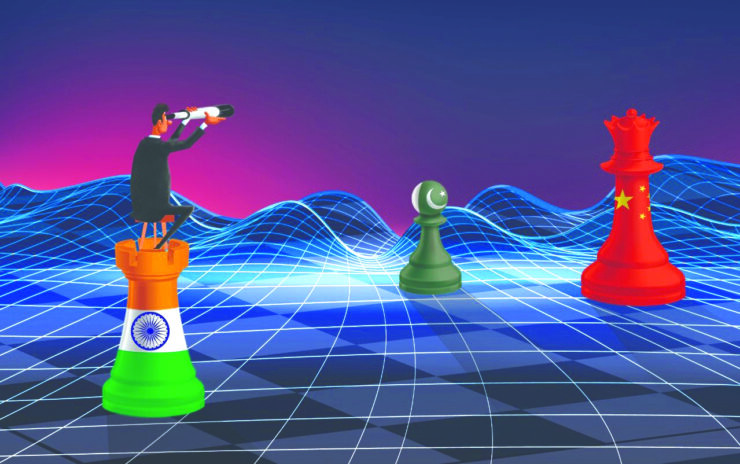
As any other country with its strategic interests and international standing at heart would, India is thinking about the future of its defence system. Facing adversaries such as Pakistan, and China to an even greater extent, it is wisely considering the potential confrontation of high-tech capacities, in confined inter-services areas which require real-time and global monitoring, if they are to allow operations to be properly commanded.
This requires systems to manage information, to exchange and integrate data, and to communicate.
While we yield to experts on these technical and operational subjects, we choose to draw the reader’s attention towards the fact that mastering these developments may be a necessity, but is entirely insufficient, in the art of warfare, to reach success.
It is indeed useless, if it is not part of a broader and more sustainable approach, which links these developments to a global understanding of strategy and operations, and ensures a seamless continuity between the accurate, relevant and articulated control of the ends, on the one hand, and the synchronised implementation of means, on the other.
The keyword, in this art, is integration. And, more to our point, “effect integration”.
In lieu of introduction only, as complete command of the subject is the object of entire curricula in Western war colleges, and the daily work of command centres of all kinds, we shall present in this article a few key-ideas around the notion of effect thinking.
Before we do so, let’s put an end, once and for all, to the simplistic objection which states that, given the moderate success of Western military engagements over the past couple of decades, the pitiful departure from Afghanistan being the sad epitome, the manner in which these campaigns were designed and executed makes a poor case, and should be abandoned.
This is a mistake: the method is not the problem, it is even the synthesis of what the West has done best, over the past century (the West being taken in its broader sense, including Soviet Russia), the ingredients within are the problem.
And, first and foremost, the political intentions and objectives, which translate into the relevance of results. A poorly-designed political intent, or an unrealistic one, or one designed regardless of geopolitical and strategic realities, are all it takes to skew the entire reasoning.
We will therefore be examining “effect integration”, and two steps in the reasoning method. The former involves defining the “what” which is to be obtained, otherwise known as designing the effects. The latter will be the “how”, or the planning of actions intended to achieve this effect.
Let’s take them one by one.
What do we want to achieve?
The “what”: the name of the game, here, is to define what we want to achieve with the campaigns (be they military or other, but more on that later on) at hand.
 Effects are defined as the change which occurs in the physical state of a system (aerial defence, energy production, banking or road infrastructure…) or in the physical or psychological state of a human agent (which can be individual, like a head of State, or collective, like a reserve army) after an action or a series of actions, or even the absence of actions. This question, as suggested above, must even be asked at the political level: what does the political decision-maker want, on the political and strategic level?
Effects are defined as the change which occurs in the physical state of a system (aerial defence, energy production, banking or road infrastructure…) or in the physical or psychological state of a human agent (which can be individual, like a head of State, or collective, like a reserve army) after an action or a series of actions, or even the absence of actions. This question, as suggested above, must even be asked at the political level: what does the political decision-maker want, on the political and strategic level?
The military level has a key-role in leading its political chief to ask himself the right questions, and to answer them. Moreover, military leaders can and must help their political chiefs, in terms of methods of thinking. They must even, should the need be, not hesitate to oppose biased reasonings. On this, hinge the efficiency of future actions, overall success, and the life or death of the men and women deployed on active battlefields, and many other factors. The courage of great military leaders also lies here.
The question of change focuses on the parameters of a given situation. Which changes do we want to achieve within an initially unsatisfactory situation, or which absence of change do we wish to guarantee on satisfactory parameters? Starting with what NATO calls the endstate, of political essence, we will focus on all the sub-parameters which lead to it: diplomatic, economic, social, legal, financial, cultural, informational and, naturally, military.
What is their current state, are we satisfied with it, and in what future state should these parameters be in order to contribute to the endstate. How does each one break down in particular items, and how are they linked to one another (we then speak of a systemic study)?
Based on this, which alterations should be operated on all or part of these parameters at the N-1 level, in order to achieve the desired change on the N-level parameters. These questions address parameters which can be more or less granular, according to the level of focus (political, military, operational or tactical): the higher up we consider things, the larger and more global these parameters are. The lower we go, the more precise and potentially selective these parameters will be.
Thus, the national defence agencies of a power such as India will consider all factors, at the global level, or at least at the Indo-Pacific level, whereas the lower commander of an Indian Land Component will only consider what is part of his future area of action: local players, air-land military power balance, characteristics of the geophysical environment within his reach…
As a result of this study, we have a tree structure of all intermediate effects, on the parameters of the situation, which enable shifting from the initial state to the endstate.
In other terms, what we are talking about is the design and definition of means, articulated amongst one another within space and time. This tree structure can be organised by dominants, which NATO refers to as “lines of operations”.
In the work of a military staff, everything revolves around interdisciplinarity, information exchange, shared understanding, and breathing between the contributions of experts on the one hand, and the construction of a global vision on the other. This is a necessity in the staff’s work, and ideally for the reasons stated above, it is theoretically even more vital in the interdepartmental work which should rule upon the definition of political ends.
Alas, only a handful of countries have understood this and integrate this into their decision-making processes, beyond partisan squabbles, ego confrontations, and actions only led by particular interests, may they stem from individuals or organisations.
How do we choose to achieve what we want?
The “how”: Once the objectives have been sequenced and validated by the appropriate-level authority, and the authority of the level above, the staff’s work is to elaborate the “how”, which are the options to reach the effects previously defined. This phase, which gradually brings us towards action, requires us to elaborate the modes of action, the combinations in time and space of the resources at hand, according to each one’s ability to achieve all or part of the desired effects.
This tree structure can be organised by dominants, which NATO refers to as “lines of operations”
This task, which calls upon the particular expertise of each capacity which can be mobilized (hence their representation in, for example, joint HQs as specialized cells: land, sea, air and cyber), must be carried out not only for friendly forces, but for the enemy as well (insofar as we understand its doctrines and capacities).
Furthermore, and this is a key element of the modern-day development of these methods, it must be performed with regard to all of the players we will be interacting with, and whose actions can interfere with ours, and those of the enemy.
To remain stuck in a dual representation of operational engagements, when at an operative or strategic level, amounts to keeping a subordinate mindset, suitable to a company or battalion commander, and leads to overlooking the operational realities from above, necessary to operations leadership.
At the end of this collective and interdisciplinary endeavour, the leader will choose amongst various action hypotheses. Once the choice is made, it is clearly laid out in an OPLAN, which links the desired effects with the actions which are planned to achieve them.
No achievement without clear and realistic vision
Once the political greenlight has been given, the time has come for operational engagement, and the shift from operational design, which comes from abstraction from reality and designed to give bearings to an entire system, to actual confrontation to reality.
As previously noted, if the representation of reality was flawed and biased during the design phase, by ideological misconceptions, centrifugal interests or a lack of courage on the staff officers’ part to correct their superior, or even from the highest ranking officer’s part to correct the political decision-maker if they think are being misled, there is a high chance that the plan will not survive the first musket-shot.
Should this occur, having the most advanced equipment, the strongest-willed men, and the most advanced real time command-and-control information systems, the most one can hope for is a handful of tactical victories. The path will then be set, from half-victories to actual defeats, in the hope to achieve an ill-designed endstate, on the basis of flawed reasoning.
This will be all the more the case, if the players, both military and political, collectively remain in a purely-military perspective, despite claiming otherwise and stating that they aim for a global resolution of crises. This would amount to simply forgetting about the existence of half of their arsenal, with all of the power tools of “Unrestricted Warfare”, which Chinese officers brilliantly theorized 20 years ago. We will perhaps have a future opportunity to look deeper into this.
– The writer is a defence and security industry consultant having varied experience working with medium and large companies majorly in European market. The views expressed are personal and do not necessarily reflect the views of Raksha Anirveda








